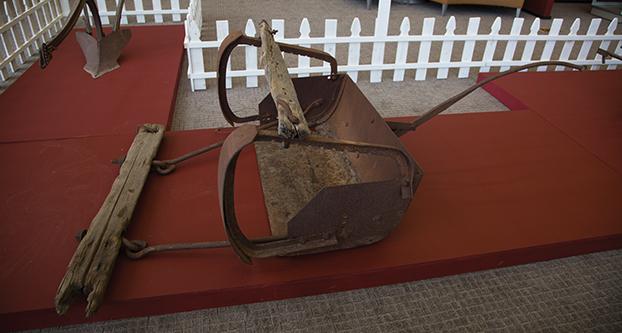A white picket fence encloses a large, rusted antique machine that is said to have changed agriculture throughout the world, dating back to the 19th century. On a nearby wall, a screen flashes through traditional recipes, offering insight into the foods consumed by families who settled in the Central Valley.
These two pieces, bridge the gap among the various cultures and their contributions to the farming community, as a part of the newest exhibition titled “Farm to Fork: Food, Family, and Farming” which opened Sept. 18 in the Leon S. Peters Ellipse Gallery at Fresno State’s Henry Madden Library.
In one of the most agriculturally productive and ethnically diverse places in the world, the exhibition tries to convey the large culinary and agriculture history of the ethnic populations in the Valley.
The exhibition is drawn largely from the Tulare County Museum of Farm Labor and Agriculture and was inspired by Tammy Lau, the head of the university library’s special collections research center.
“I’ve been thinking about it for several years, and when I discovered that the Tulare County Museum has been doing a series of exhibits on different ethnic groups in Tulare County, it all came together because that’s what I’ve been trying to do,” said Lau.
Over a dozen kitchen implements donated by families in Tulare County are juxtaposed with several larger pieces of farming equipment, representing the development of agriculture.
“The kitchen implements come from a different world. These aren’t things that were made for just decorative purpose, they’re utilitarian pieces from people’s houses, and they used them,” said Lau.
Her goal is to preserve some of the Valley’s history and traditions for future generations.
Additionally, large photos of farmworkers, children and adults alike, hang above captions describing multiple ethnic groups, such as Armenians, Basque, Chicanos and Southeast Asians, and their connection to the Valley.
“It’s a wonderful exhibition celebrating our Valley’s agricultural heritage,” said Cindy Wathen, public affairs communication specialist for the library. “It gives greater exposure to all the cultures that have been part of the farm community.”
One of the more historical pieces of the exhibition on loan from The Tulare County Museum is the Fresno Scraper.
“The Fresno Scraper is one of the most important agricultural and civil engineering machines ever made,” said museum curator Amy King.
The scraper, invented in 1883 by James Porteous, changed farming by having a blade designed to scoop dirt and dispose of it in a controlled manner by an operator. King said that Porteous designed the scraper after he worked with Fresno farmers and noticed their need to for an efficient way to dig canals.
“We thought it would be neat for people to see a piece of farm equipment that was invented in the Fresno area,” said King.
The scraper, primarily used for canals, ditches and land leveling, also played a vital role during the construction of the Panama Canal and later utilized by the U.S. Army in War World I.
Numerous displays are still awaiting installation primarily in conjunction with the video presentation of the recipes.
However, the exhibition is only one of many activities involved with “Farm to Fork.” Several events are scheduled until next May to celebrate the event. The first activity following the exhibition will be “The Great Grape” slated for Saturday, Oct. 10.
“The Great Grape” will be held in the Viticulture Center, where the public will be able to take tours of the campus winery, as well as view the different aspects involved in making wine, which Wathen said would be a great opportunity for the public to celebrate and learn about that heritage.




